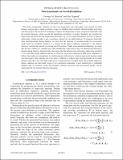| dc.contributor.author | Peterson, Courtney M. | |
| dc.contributor.author | Tegmark, Max Erik | |
| dc.date.accessioned | 2011-12-02T16:36:11Z | |
| dc.date.available | 2011-12-02T16:36:11Z | |
| dc.date.issued | 2011-07 | |
| dc.date.submitted | 2010-12 | |
| dc.identifier.issn | 0556-2813 | |
| dc.identifier.uri | http://hdl.handle.net/1721.1/67346 | |
| dc.description.abstract | We derive semianalytic formulas for the local bispectrum and trispectrum from general two-field inflation and provide a simple geometric recipe for building observationally allowed models with large non-Gaussianity. We use the δN formalism to express the bispectrum in terms of spectral observables and the transfer functions, which encode the superhorizon evolution of modes. Similarly, we calculate the trispectrum and show that the trispectrum parameter τNL can be expressed entirely in terms of spectral observables, which provides a new consistency relation for two-field inflation. To generate observably large non-Gaussianity during inflation, we show that the sourcing of curvature modes by isocurvature modes must be extremely sensitive to a change in the initial conditions orthogonal to the inflaton trajectory and that the amount of sourcing must be nonzero. Under some minimal assumptions, we argue that the first condition is satisfied only when neighboring trajectories in the two-dimensional field space diverge during inflation. Geometrically, this means that the inflaton must roll along a ridge in the potential V for some time during inflation and that its trajectory must turn somewhat in field space. Therefore, it follows that under our assumptions, two-field scenarios with attractor solutions necessarily produce small non-Gaussianity. This explains why it has been so difficult to achieve large non-Gaussianity in two-field inflation and why it has only been achieved in a small fraction of models where the potential and/or the initial conditions are fine-tuned. Some of our conclusions generalize at least qualitatively to multifield inflation and to scenarios where the interplay between curvature and isocurvature modes can be represented by the transfer function formalism. | en_US |
| dc.description.sponsorship | National Science Foundation (U.S.) (grant AST-0708534) | en_US |
| dc.description.sponsorship | National Science Foundation (U.S.) (grant AST-0908848) | en_US |
| dc.description.sponsorship | David & Lucile Packard Foundation | en_US |
| dc.language.iso | en_US | |
| dc.publisher | American Physical Society | en_US |
| dc.relation.isversionof | http://dx.doi.org/10.1103/PhysRevD.84.023520 | en_US |
| dc.rights | Article is made available in accordance with the publisher's policy and may be subject to US copyright law. Please refer to the publisher's site for terms of use. | en_US |
| dc.source | APS | en_US |
| dc.title | Non-Gaussianity in two-field inflation | en_US |
| dc.type | Article | en_US |
| dc.identifier.citation | Peterson, Courtney, and Max Tegmark. “Non-Gaussianity in Two-field Inflation.” Physical Review D 84.2 (2011) © 2011 American Physical Society | en_US |
| dc.contributor.department | Massachusetts Institute of Technology. Department of Physics | en_US |
| dc.contributor.department | MIT Kavli Institute for Astrophysics and Space Research | en_US |
| dc.contributor.approver | Tegmark, Max Erik | |
| dc.contributor.mitauthor | Tegmark, Max Erik | |
| dc.relation.journal | Physical Review D | en_US |
| dc.eprint.version | Final published version | en_US |
| dc.type.uri | http://purl.org/eprint/type/JournalArticle | en_US |
| eprint.status | http://purl.org/eprint/status/PeerReviewed | en_US |
| dspace.orderedauthors | Peterson, Courtney; Tegmark, Max | en |
| dc.identifier.orcid | https://orcid.org/0000-0001-7670-7190 | |
| mit.license | PUBLISHER_POLICY | en_US |
| mit.metadata.status | Complete | |
